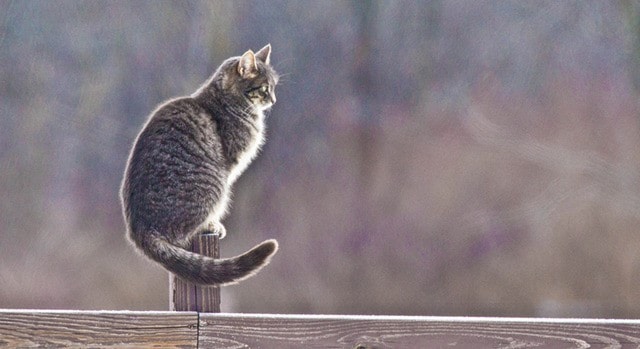We have a cat. He’s black. He wandered into our barn one day in July 2009. He was scrawny thin, skittish, full of worms, wouldn’t be touched, but in the barn he found rodent groceries just to his liking.
We had no idea where he came from or how old he was. But we’d had black cats before and “Raven” we suspected was a descendant of one of them. He was an undisputed knock-off of Raven No. 1 that we adopted as a kitten 23 years ago.
We became Raven’s humans. He came to trust us. He followed us to the house one day, walked in one door and out the other, and decided the human barn was better than the horse one. He took up residence on his cat mat and stayed. He got wormed. He got neutered. That controlled his urge to wander, breed, and get into fights. But it caused him to take a raincheck on humans for a while. He stayed, but with conditions. Meals were to be served at set times, on time. Petting was allowed. Laps were required. A kitty litter tray was not an option. And he would be free to come and go to hunt mice and birds at will.
I bring up Raven’s story because the conservation organization Nature Canada wants all cat owners to keep their cats indoors and stop them from hunting, to protect birds. In 2013, Environment Canada estimated that 270 million birds are killed in Canada every year and topping the reasons for bird deaths are cats, both pets and feral. Their report stated that cat predation coupled with collisions with tall buildings and transmission lines account for more than 95 per cent of bird losses. Industrial causes of mortality include electrical power (towers), agricultural sectors (haying and harvest), forestry (destruction of nests in trees), loss of habitat (grassland, brush, and wetlands) because of urban spread, flying into glass windows of homes and being killed through the impact of wind turbines.
This week Nature Canada launched its campaign “Keep Cats Safe and Save Birds’ Lives”. Nothing wrong with that in principle. Cats face two high mortalities when hunting. Whether in the city or the country, they are victim to being run over or becoming prey for coyotes and other predators. As for birds, the greatest impact of cats is on birds that spend time feeding on the ground such as thrushes, sparrows, and juncos.
According to Nature Canada, on a global scale cats have contributed to the extinction of 34 species of birds. Indeed, birds worldwide are in trouble. One in eight of the world’s bird species is considered threatened and 217 critically endangered species are at risk of imminent extinction. Songbirds are in serious decline across North America. Some 44 per cent of Canada’s 460 plus bird species have fallen in number, some by as much as 80 per cent, especially aerial insectivores such as barn swallows, swifts, and flycatchers. Climate change isn’t helping as migration times and seasonally emerging foods (seeds, pollinating flowers, or insects) are no longer dovetailing at critical times.
But, really, how realistic is the no-roaming cause for cats? Some people have trained their cats to walk on a leash. Other people have constructed a feline outdoor pen. But for many cats the urge to hunt is so overwhelming it’s ingrained in their DNA and no amount of containment or control will quell their yowling to be let out, perhaps eventually to their peril.
Raven is aging now. His wanderings are far less and he seldom ventures further than the garden where, I hate to admit, he is still the renowned Darth Vader of the vegetable patch.
